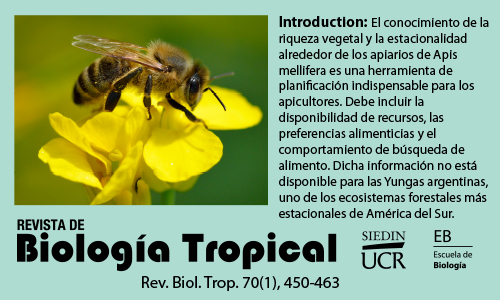Abstract
Introduction: Knowledge of vegetation richness and seasonality around Apis mellifera apiaries is an indispensable planning tool for beekeepers. It must include resource availability, food preferences and foraging behaviour. Such information is unavailable for the Argentinian Yungas, one of the most seasonal forest ecosystems in South America. Objective: To assess the availability of trophic resources through a flowering calendar and its relationship with A. mellifera pollen loads in the Yungas. Methods: In El Fuerte, Jujuy, we collected monthly samples from September to March (2014-2015 and 2015-2016) using pollen traps. We used standardized techniques for palynological analyses, and association indices for resource use. The phenophases were Beginning of flowering, Full flowering, and End of flowering. Results: We identified 47 botanical specimens to species level and 9 only to genus. In both periods there was a moderate supply of flowers at the beginning of spring, represented equally by shrub and herbaceous plants, with peak flowering in November. Subsequently, there was a drop in availability, with peak flowering again at the end of the season. In five plant species, there was a medium to high association between the plant species available and their presence in the pollen spectrum of the corbicular pollen samples collected (Vachellia aroma, Blepharocalyx salicifolius, Cantinoa sp., Vernonanthura sp. And Zanthoxylum coco). Conclusion: In this region, there is a moderate supply of shrub and herbaceous plant flowers at the beginning of spring, with peak flowering in November and at the end of the season. Only five, out of nearly 50 plant species, show an association of availability and use by bees.
##plugins.facebook.comentarios##

This work is licensed under a Creative Commons Attribution 4.0 International License.
Copyright (c) 2022 Revista de Biología Tropical



